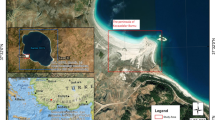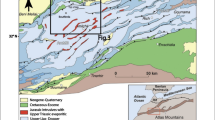Abstract
The traditional approaches of mineral-mapping are time consuming and expensive process. Remote sensing is a tool to map the minerals precisely using their physical, chemical and optical properties. In the present study, Tirunelveli district in Tamil Nadu is selected to extract the abundant mineral such as Limestone using Hyperion and Landsat-8 OLI imageries. The chemical composition of the mineral is identified using scanning electron microscope (SEM) and energy dispersive X-ray spectroscopy (EDS) analysis. The spectral reflectance of minerals is characterized using analytical spectral device (ASD) field spectroradiometer. The minerals showed deep absorption in short wave infrared region from 1800 to 2500 nm. The mineral mapping in hyperspectral data is performed using various preliminary processing such as bad band removal, vertical strip removal, radiance and reflectance generation and postprocessing steps such as data dimensional reduction, endmember extraction and classification. To improve the classification accuracy, the vertical strip removal process is performed using a local destriping algorithm. Absolute reflectance of Hyperion and Landsat-8 OLI (Operational Land Imager) imageries is carried out using the FLAASH (fast line-of-sight atmospheric analysis of hypercubes) module. Spectral data reduction techniques in reflectance bands performed using minimum noise fraction method. The noiseless reflectance bands spatial data reduced by the Pixel Purity Index method in the threshold limit of 2.5 under 10,000 repetitions. The obtained reflectance imagery spectra compared with the spectral libraries such as USGS (United States Geological Survey), JPL (Jet Propulsion Laboratory) and field spectra. Endmembers of minerals are carried out using high probability score obtained from the various methods such as SAM (spectral angle mapper), SFF (spectral feature fitting) and BE (binary encoding). The mineral mapping of both imageries is carried out using a supervised classification approach. The results showed that hyperspectral remote sensing performed good results as compared to multispectral data.












Similar content being viewed by others
References
Ahmadirouhani R, Karimpour MH, Rahimi B, Malekzadeh-Shafaroudi A, Pour AB, Pradhan B (2018) Integration of SPOT-5 and ASTER satellite data for structural tracing and hydrothermal alteration mineral mapping: implications for Cu–Au prospecting. Int J Image Data Fusion 9(3):237–262
Arellano P, Tansey K, Balzter H, Boyd DS (2015) Detecting the effects of hydrocarbon pollution in the Amazon forest using hyperspectral satellite images. Environ Pollut 205:225–239
Askari G, Pour A, Pradhan B, Sarfi M, Nazemnejad F (2018) Band ratios matrix transformation (BRMT): a sedimentary lithology mapping approach using ASTER satellite sensor. Sensors 18(10):3213
Beiranvand Pour A, Park TY, Park Y, Hong J, Zoheir B, Pradhan B et al (2018) Application of multi-sensor satellite data for exploration of Zn–Pb sulfide mineralization in the Franklinian Basin, North Greenland. Remote Sens 10(8):1186
Chuan Z, Fawang Y, Haixia H, Hongcheng L (2014) Study on the forest vegetation restoration monitoring using HJ-1A hyperspectral data. In IOP Conference Series: Earth Environ Sci 17(1):012082
Crosta AP, de Souza Filho CR (2017) Hyperspectral remote sensing for mineral mapping: a case-study at alto Paraiso de Goías, central Brazil. Rev Bras Geosci 30(3):551–554
El-Magd IA, El Kafrawy S, Farag I (2014) Detecting oil spill contamination using airborne hyperspectral data in the River Nile, Egypt. Open J Marine Sci 4(2):140
Honkavaara E, Kaivosoja J, Mäkynen J, Pellikka I, Pesonen L, Saari H et al (2012) Hyperspectral reflectance signatures and point clouds for precision agriculture by light weight UAV imaging system. ISPRS Ann. Photogramm. Remote Sensing Spatial Inform Sci I-7:353–358
Kruse FA (2003) Mineral mapping with AVIRIS and EO-1 Hyperion. In: Presented at the 12th JPL Airborne Geoscience Workshop, 24–28 February, 2003. California, Pasadena
Kruse FA, Bedell RL, Taranik JV, Peppin WA, Weatherbee O, Calvin WM (2012) Mapping alteration minerals at prospect, outcrop and drill core scales using imaging spectrometry. Int J Remote Sens 33(6):1780–1798
Kruse, F. A and Boardman, J. W. (2000). Characterization and mapping of kimberlites and related diatremes using hyperspectral remote sensing. Proceedings, 2000 IEEE Aerospace Conference., Big Sky, MO, March 18–24
Kruse FA, Bordman JW, Huntington JF (2003) Comparison of airborne hyperspectral data and EO-1 Hyperion for mineral mapping. IEEE Transac Geosci Remote Sensing 41(6):1388–1400
Kruse FA, Perry SL (2007) Regional mineral mapping by extending hyperspectral signatures using multispectral data. IEEE Transac Geosci Remote Sensing 4:1–14
Kumar MV, Yarrakula K (2017) Comparison of efficient techniques of hyper-spectral image preprocessing for mineralogy and vegetation studies. Ind J Geomarine Sci 46:1008–1021
Kumari SK, Debashish C, Pulakesh D, Jatisankar B (2014) Hyperion image analysis for iron ore mapping in Gua Iron Ore Region. Int Res J Earth Sci 2:1–6
Lin L, Wang Y, Teng J, Wang X (2016) Hyperspectral analysis of soil organic matter in coal mining regions using wavelets, correlations, and partial least squares regression. Environ Monit Assess 188(2):97
Matar SS, Bamousa AO (2013) Integration of the ASTER thermal infra-red bands imageries with geological map of Jabal Al Hasir area, Asir Terrane, the Arabian Shield. J Taibah Univer Sci 7(1):1–7
Moroni M, Lupo E, Marra E, Cenedese A (2013) Hyperspectral image analysis in environmental monitoring: setup of a new tunable filter platform. Procedia Environ Sci 19:885–894
Noori L, Pour AB, Askari G, Taghipour N, Pradhan B, Lee CW, Honarmand M (2019) Comparison of different algorithms to map hydrothermal alteration zones using ASTER remote sensing data for polymetallic vein-type ore exploration: Toroud–Chahshirin Magmatic Belt (TCMB), North Iran. Remote Sens 11(5):495
Panda S, Banerjee K, Jain MK (2014) Mapping of iron minings of Noamundi Areas, Jharkhand by using the image based Ndii and Geospatial Technology. Int J Innovation Sci Res 7:5–10
Peng, H. (2014). Automatic Denoising and Unmixing in Hyperspectral image processing. Rochester Institute of Technology
Pour BA, Hashim M, van Genderen J (2013) Detection of hydrothermal alteration zones in a tropical region using satellite remote sensing data: Bau gold field, Sarawak. Malay Ore Geol Rev 54:181–196
Ramakrishnan D, Nithya M, Singh KD, Bharti R (2013) A field technique for rapid lithological discrimination and ore mineral identification: results from Mamandur Polymetal Deposit, India. J Earth System Sci 122(1):93–106
Renaud, K.M. (2015). Minerals yearbook
Scheffler D, Karrasch P (2013) Preprocessing of hyperspectral images: a comparative study of destriping algorithms for EO1-Hyperion. In SPIE Remote Sensing. International Society for Optics and Photonics, p 88920
Sheikhrahimi A, Pour AB, Pradhan B, Zoheir B (2019) Mapping hydrothermal alteration zones and lineaments associated with orogenic gold mineralization using ASTER data: a case study from the Sanandaj-Sirjan zone, Iran. Adv Space Res 63(10):3315–3332
Sun Z, Zhao Y, Yan G, Li S (2011) Study on the hyperspectral polarized reflection characteristics of oil slicks on sea surfaces. Chin Sci Bull 56(15):1596–1602
Tiwari SK, Saha SK, Kumar S (2015) Prediction modeling and mapping of soil carbon content using artificial neural network, hyperspectral satellite data and field spectroscopy. Adv Remote Sens 4(01):63
Tsai, F., Lin, S. Q., Rau, J. Y., Chen, L. C., & Liu, G. R. (2005). Destriping hyperion imagery using spline interpolation. In Proc. 26th Asian Conference on Remote Sensing
Yarrakula K, Deb D, Samanta B (2013) Comparative evaluation of Cartosat-1 and SRTM imageries for digital elevation modelling. Geo-spatial Inform Sci 16(2):75–82
Zaini N, van der Meer F, van der Werff H (2014) Determination of carbonate rock chemistry using laboratory-based hyperspectral imagery. Remote Sens 6(5):4149–4172
Zhang L, Du B (2012) Recent advances in hyperspectral image processing. Geo-spatial Inform Sci 15(3):143–156
Author information
Authors and Affiliations
Corresponding author
Additional information
This article is part of the Topical Collection on Global Sustainability through Geosciences and Civil Engineering
Rights and permissions
About this article
Cite this article
Vignesh, K.M., Kiran, Y. Comparative analysis of mineral mapping for hyperspectral and multispectral imagery. Arab J Geosci 13, 160 (2020). https://doi.org/10.1007/s12517-020-5148-8
Received:
Accepted:
Published:
DOI: https://doi.org/10.1007/s12517-020-5148-8




